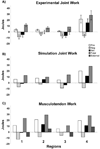Forward dynamics simulations provide insight into muscle mechanical work during human locomotion
- PMID: 19955870
- PMCID: PMC2789343
- DOI: 10.1097/JES.0b013e3181b7ea29
Forward dynamics simulations provide insight into muscle mechanical work during human locomotion
Abstract
Complex musculoskeletal models and computer simulations can provide critical insight into muscle mechanical work output during locomotion. Simulations provide both a consistent mechanical solution that can be interrogated at multiple levels (muscle fiber, musculotendon, net joint moment, and whole-body work) and an ideal framework to identify limitations with different estimates of muscle work and the resulting implications for metabolic cost and efficiency.
Figures




Similar articles
-
The relationships between muscle, external, internal and joint mechanical work during normal walking.J Exp Biol. 2009 Mar;212(Pt 5):738-44. doi: 10.1242/jeb.023267. J Exp Biol. 2009. PMID: 19218526 Free PMC article.
-
A two-muscle, continuum-mechanical forward simulation of the upper limb.Biomech Model Mechanobiol. 2017 Jun;16(3):743-762. doi: 10.1007/s10237-016-0850-x. Epub 2016 Nov 11. Biomech Model Mechanobiol. 2017. PMID: 27837360
-
Modeling and simulating the neuromuscular mechanisms regulating ankle and knee joint stiffness during human locomotion.J Neurophysiol. 2015 Oct;114(4):2509-27. doi: 10.1152/jn.00989.2014. Epub 2015 Aug 5. J Neurophysiol. 2015. PMID: 26245321 Free PMC article.
-
Biomechanics and muscle coordination of human walking: part II: lessons from dynamical simulations and clinical implications.Gait Posture. 2003 Feb;17(1):1-17. doi: 10.1016/s0966-6362(02)00069-3. Gait Posture. 2003. PMID: 12535721 Review.
-
Biomechanics and muscle coordination of human walking. Part I: introduction to concepts, power transfer, dynamics and simulations.Gait Posture. 2002 Dec;16(3):215-32. doi: 10.1016/s0966-6362(02)00068-1. Gait Posture. 2002. PMID: 12443946 Review.
Cited by
-
Posture shifting after spinal cord injury using functional neuromuscular stimulation--a computer simulation study.J Biomech. 2011 Jun 3;44(9):1639-45. doi: 10.1016/j.jbiomech.2010.12.020. J Biomech. 2011. PMID: 21536290 Free PMC article.
-
A comparative collision-based analysis of human gait.Proc Biol Sci. 2013 Oct 2;280(1771):20131779. doi: 10.1098/rspb.2013.1779. Print 2013 Nov 22. Proc Biol Sci. 2013. PMID: 24089334 Free PMC article.
-
Does joint impedance improve dynamic leg simulations with explicit and implicit solvers?PLoS One. 2023 Jul 3;18(7):e0282130. doi: 10.1371/journal.pone.0282130. eCollection 2023. PLoS One. 2023. PMID: 37399198 Free PMC article.
-
Essential kinematic information, athletic experience, and affordance perception for others.Psychon Bull Rev. 2014 Jun;21(3):823-9. doi: 10.3758/s13423-013-0539-4. Psychon Bull Rev. 2014. PMID: 24243136
-
A Dynamic Simulation of Musculoskeletal Function in the Mouse Hindlimb During Trotting Locomotion.Front Bioeng Biotechnol. 2018 May 16;6:61. doi: 10.3389/fbioe.2018.00061. eCollection 2018. Front Bioeng Biotechnol. 2018. PMID: 29868576 Free PMC article.
References
-
- Anderson FC, Pandy MG. Dynamic optimization of human walking. J Biomech Eng. 2001;123(5):381–390. - PubMed
-
- Bhargava LJ, Pandy MG, Anderson FC. A phenomenological model for estimating metabolic energy consumption in muscle contraction. J Biomech. 2004;37(1):81–88. - PubMed
-
- Blemker SS, Asakawa DS, Gold GE, Delp SL. Image-based musculoskeletal modeling: applications, advances, and future opportunities. J Magn Reson Imaging. 2007;25(2):441–451. - PubMed
-
- Cahouet V, Luc M, David A. Static optimal estimation of joint accelerations for inverse dynamics problem solution. J Biomech. 2002;35(11):1507–1513. - PubMed
-
- Doke J, Donelan JM, Kuo AD. Mechanics and energetics of swinging the human leg. J Exp Biol. 2005;208(Pt 3):439–445. - PubMed
Publication types
MeSH terms
Grants and funding
LinkOut - more resources
Full Text Sources
Other Literature Sources

